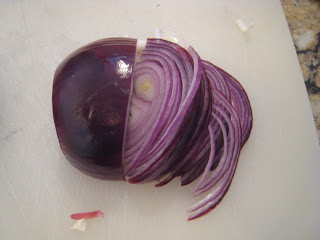The recipe presented here is influenced by Peru’s “adobo” chicken and feeds 6. This chicken is delicious and works really well for barbecues but here I am cooking it on the frying pan. Below is a serving suggestion with white rice (see our rice recipe) and greens with simple dressing (see our dressing recipe)
Recipe Ingredients
2. 5 pounds of chicken breast tenders (although any cut of chicken will do)
1 onion (red)
1/3 cup distilled white vinegar
1 1/2 cup water
1 tbs salt
5 tbs Aji Panca pepper paste**
4 tbs vegetable oil
1 tbs ground cumin
1 ½ tbs minced garlic
½ tsp ground black pepper
**(can be substituted with 2 tbs of tomato paste and 1 tsp of cayenne pepper powder)
Preparation
Any marinade includes these four basic elements: salt, an acid (such as vinegar or lemon juice), an oil, and hot pepper paste. The salt forces the chicken to absorb the flavors of the three other elements; the sour element softens the meat; the oil gives the meat richness and ensures that it does not dry out when it is cooked; and the pepper adds spiciness and gives the marinate ‘body’.
Step 2: Cut onion into eighths and place into bowl with chicken. It helps to have large chunks of onion not only to flavor the marinade, but to cook with the chicken later on.
Step 3: Add vinegar, water, salt , pepper paste, and vegetable oil to bowl.
Step 4: Add ground cumin, minced garlic, and black pepper to bowl.
Step 5: Mix together all ingredients in the bowl with tongs. Break onions up a bit and ensure that all the chicken and onions are semi-submerged (If you are using the tomato paste substitute for the pepper paste stir extra to make sure the tomato paste dissolves entirely!).
Step 6: Let chicken marinade for 10-15 minutes.
Step 7: After letting the chicken soak in marinade we are ready to cook. Coat frying pan with approx. ¾ tbs of oil. You dont want a lot of extra oil floating around-just enough to coat the bottom. Then let the pan heat up, on high heat.
Step 8: Once the oil becomes watery (about 2-3 minutes on a gas stove), you are ready to begin cooking the chicken. Don’t overheat the pan, as when you throw the chicken in, the hot oil may splash and burn you. To test whether the pan is hot enough, carefully place a piece of onion or a small piece of chicken into the pan, using tongs. If the chicken or onion is crackling in the oil, the pot is hot enough-go ahead and place a few pieces of chicken into the pan-as you move the chicken from the marinade, shake the chicken a bit to remove excess marinade. Be careful not to overcrowd the pan.
Step 9: Flip chicken over every 1-2 minutes. As you cook the chicken, there will be some marinade in the pan, let the chicken cook on high in that marinade. The marinade will reduce (become thicker) as the chicken cooks. As the marinade reduces, it will begin to splatter-once that happens, turn the heat from high to medium.
Step 10: After 5-7 minutes, when the chicken is nearly done and the marinade has reduced substantially, return heat to high and cook for 45 seconds on each side-this will help caramelize the outside of the chicken and onion for extra flavor. During this process, the chicken and onions will become slightly browned. With the heat on high, you will also want to make sure that nothing is sticking to the bottom of the pan-a constant problem when the heat is on high and the sauce has reduced. In total, the chicken will take about 10 minutes to cook.
Below you can see the browning on the chicken.
Step 11: Repeat for pan-frying for all of the marinated chicken. For the amount of chicken we used (about 2 ½ pounds of chicken breast tenders), we had to do a few rounds of cooking. In my large frying pan, it took me 3 rounds.



































